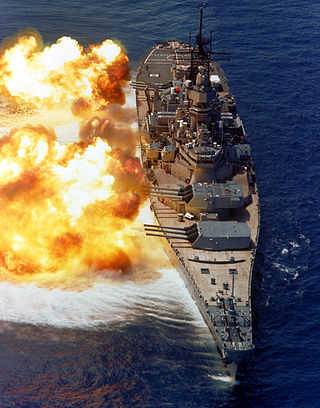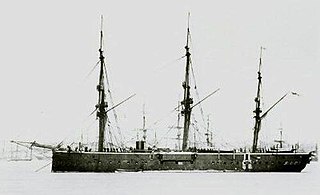Related Research Articles

A battleship is a large, heavily armored warship with a main battery consisting of large-caliber guns, designed to serve as capital ships with the most intense firepower. Before the rise of supercarriers, battleships were among the largest and most formidable weapon systems ever built.
Seven ships of the Royal Navy have been named HMS Africa, after the continent of Africa. Two others were planned:

HMS Liverpool was a 4,800 ton Town-class light cruiser of the Royal Navy commissioned in 1909. Named for the port city of Liverpool, the cruiser served continuously in home waters subordinated to the Home Fleet from 1909 through the initial stages of the First World War.
Five ships of the Royal Navy have been named HMS Erebus after Erebus, the dark region of Hades in Greek Mythology.

HMS Audacious was the fourth and last King George V-class dreadnought battleship built for the Royal Navy in the early 1910s. After completion in 1913, she spent her brief career assigned to the Home and Grand Fleets. The ship was sunk by a German naval mine off the northern coast of County Donegal, Ireland, early during the First World War. Audacious slowly flooded, allowing all of her crew to be rescued and finally sank after the British were unable to tow her to shore. However, a petty officer on a nearby cruiser was killed by shrapnel when Audacious subsequently exploded. Even though American tourists aboard one of the rescuing ships photographed and filmed the sinking battleship, the Admiralty embargoed news of her loss in Britain to prevent the Germans from taking advantage of the weakened Grand Fleet. She is the largest warship ever sunk by naval mines.
Six ships and a training establishment of the Royal Navy have borne the name HMS Imperieuse:
Audacious may refer to:

HMS Prince of Wales was one of six 121-gun screw-propelled first-rate three-decker line-of-battle ships of the Royal Navy. She was launched on 25 January 1860.
Several ships of the Royal Navy have been named HMS Dragon.

HMS Audacious was the lead ship of the Audacious-class ironclads built for the Royal Navy in the late 1860s. They were designed as second-class ironclads suitable for use on foreign stations and the ship spent the bulk of her career on the China Station. She was decommissioned in 1894 and hulked in 1902 for use as a training ship. The ship was towed to Scapa Flow after the beginning of the First World War to be used as a receiving ship and then to Rosyth after the war ended. Audacious was sold for scrap in 1929.

The Audacious-class ironclad battleships were designed by Sir Edward Reed at the request of the Board of Admiralty to serve as second-class battleships on distant foreign stations.

HMS Revenge was one of seven Royal Sovereign-class pre-dreadnought battleships built for the Royal Navy during the 1890s. She spent much of her early career as a flagship for the Flying Squadron and in the Mediterranean, Home and Channel Fleets. Revenge was assigned to the International Squadron blockading Crete during the 1897–1898 revolt there against the Ottoman Empire. She was placed in reserve upon her return home in 1900, and was then briefly assigned as a coast guard ship before she joined the Home Fleet in 1902. The ship became a gunnery training ship in 1906 until she was paid off in 1913.

HMS Magnanime was a 64-gun third-rate ship of the line of the Royal Navy, launched on 14 October 1780 at Deptford Dockyard. She belonged to the Intrepid-class designed by Sir John Williams and later was razeed into a 44 gun frigate.
Five ships of the Royal Navy have been named HMS Aeolus, after one of a number of figures named Aeolus who appear in Greek mythology:
Ten ships of the Royal Navy have borne the name HMS Woolwich, after the port town and naval base of Woolwich. An eleventh was planned but entered service under a different name.
Six ships of the Royal Navy have borne the name HMS Racoon, after the raccoon:
Four ships and two shore establishments of the Royal Navy have borne the name HMS Forward:
Three ships of the Royal Navy have borne the name HMS Chub, or alternatively HMS Chubb, a name given to several types of fish, many in the family Cyprinidae:
HMS Jed was a Thornycroft type River-class destroyer ordered by the Royal Navy under the 1903 – 1904 Naval Estimates. Named after the River Jed in southern Scotland, she was the second ship to carry this name since it was introduced in 1814 for a 26-gun sixth rate ship sold in 1833.
References
- Colledge, J. J.; Warlow, Ben (2006) [1969]. Ships of the Royal Navy: The Complete Record of all Fighting Ships of the Royal Navy (Rev. ed.). London: Chatham Publishing. ISBN 978-1-86176-281-8.
- Sawyer, L A & Mitchell, W H (1995). The Empire Ships. London: Lloyd's of London Press Ltd. p. 386. ISBN 1-85044-275-4.
- This article includes data released under a Creative Commons Attribution-ShareAlike 3.0 Unported UK: England & Wales Licence, by the National Maritime Museum, as part of the Warship Histories project.